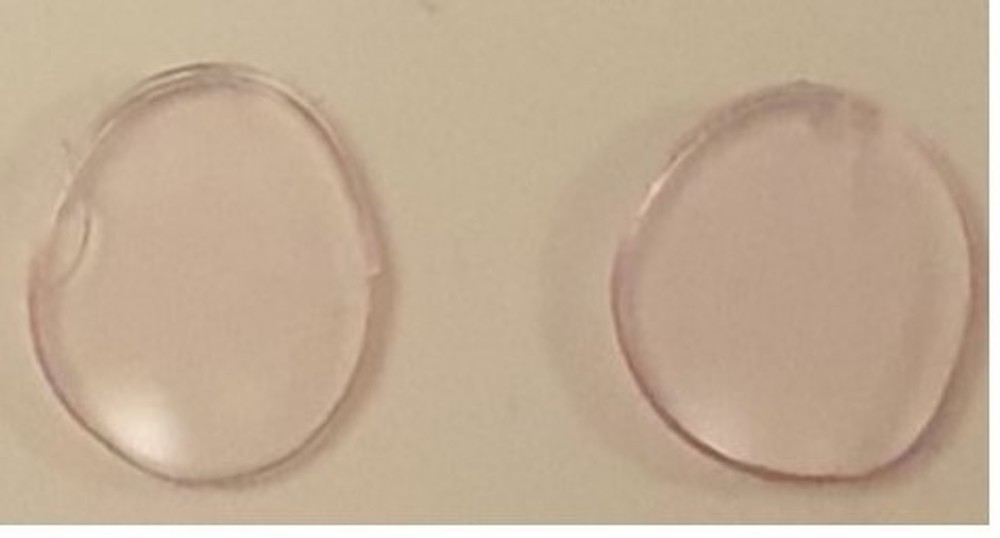
[Image above] Example of the rose-tinted contact lenses (about 10 mm in diameter) containing gold nanoparticles to filter out problematic colors for people with red-green color vision deficiency. Credit: Salih et al., ACS Nano (CC BY 4.0)
There are countless how-to articles on the internet claiming to know the secrets of making a post go viral. While certain tactics do make the chances of going viral more likely, often a post goes viral accidentally.
Sometimes virality happens when a post resonates with what society needs at that moment, such as the Sea Shanty “Wellerman” on TikTok. However, it is more likely that the post accidentally sets off an argument that quickly erupts into a big dispute, such as what happened in 2015 with “the dress.”
“The dress” refers to the viral photo of a blue-black dress that received its own Wikipedia page because of the debates over its color. Although the owner of the dress confirmed it to be blue and black, a large majority of people swore that they saw it as white and gold instead.
The dress photo generated such fierce debate because people often implicitly assume that how they see colors is how others do as well. Yes, the specific shade might be debated (is that blueish black or blackish blue?), but the general area of the color spectrum is agreed on. In the dress case, though, the two debated color combinations were very different.

Not everyone was flummoxed by the dress debate, however. In particular, people who have a color vision deficiency saw the situation as a chance for everyone to walk a mile in their shoes.
“That’s what struck me most about this whole thing taking off. ‘Color-normal’ people don’t realize the feeling they’re getting of not being able to see the same color as other people and they’re unsure of themselves. Colorblind people know they’re at a disadvantage the whole time. People who have normal color vision do not like it when they don’t see it as anyone else,” says Kathryn Albany-Ward, founder of “Colour Blind Awareness” in the U.K., in an ABC News article.
Color vision deficiency, colloquially called “color blindness,” is the term for a group of conditions that affect the perception of color. Typically, color vision deficiency is caused by genetics that affect cones in the retina of the eye, which leads to the brain perceiving certain colors differently and makes it challenging to distinguish between some colors.

Because most cases of color vision deficiency are caused by genetics, there is no way to permanently treat the condition. (Though gene therapy is being investigated as a possible treatment.) Instead, people who have color vision deficiency can manage the condition by wearing tinted glasses, which are customized to filter out a range of wavelengths based on the specific deficiency.
Tinted contact lenses also exist, but the effectiveness of these lenses vary. The lenses are tinted using dyes that often suffer from leaching and/or toxicity problems, so developing safe and effective tinted contact lenses remains an area ripe for investigation.
In a recent open-access study, researchers from Khalifa University in the United Arab Emirates, along with a colleague from Imperial College London, took a different approach to developing tinted contact lenses. Instead of a dye, they looked at incorporating gold nanoparticles into contact lenses.
“Noble metal nanoparticles (NPs), particularly gold and silver, have excellent electrical and optical properties, making them suitable for various biomedical applications like molecular imaging, targeted drug delivery, and biosensor fabrication,” they write in the paper. “Moreover, gold and silver nanoparticles’ surface plasmon resonance (SPR) facilitates their excellent light absorption and scattering properties.”
They note that gold nanocomposites already are used for a variety of optical applications, such as gold ruby glasses, which have been manufactured since the 17th century. In addition, another group has previously tried incorporating gold nanoparticles into contact lenses by exposing silicone hydrogel contact lenses to nanoparticle solutions.
In the new study, the researchers mixed gold nanoparticles into a hydrogel polymer to produce rose-tinted gels that filtered light in the range of 520–580 nm, or wavelengths where red and green overlap. Transmission spectra testing showed that lenses embedded with 40 nm-wide gold nanoparticles were the most effective because these particles did not clump or filter more color than necessary.

Further testing revealed that the lenses’ water retention and wettability properties were superior to some commercially available contact lenses used for cosmetic/vision correction purposes. In addition, in vitro cytotoxicity analysis showed that the nanocomposite lenses were not toxic to cells.
“Hence, this work demonstrates the potential of gold nanocomposite lenses in [color vision deficiency] management and, more generally, color filtering applications,” the authors conclude.
An American Chemical Society press release says that the researchers’ next step is to conduct clinical trials with human patients to assess comfort.
The open-access paper, published in ACS Nano, is “Gold nanocomposite contact lenses for color blindness management” (DOI: 10.1021/acsnano.0c09657).
